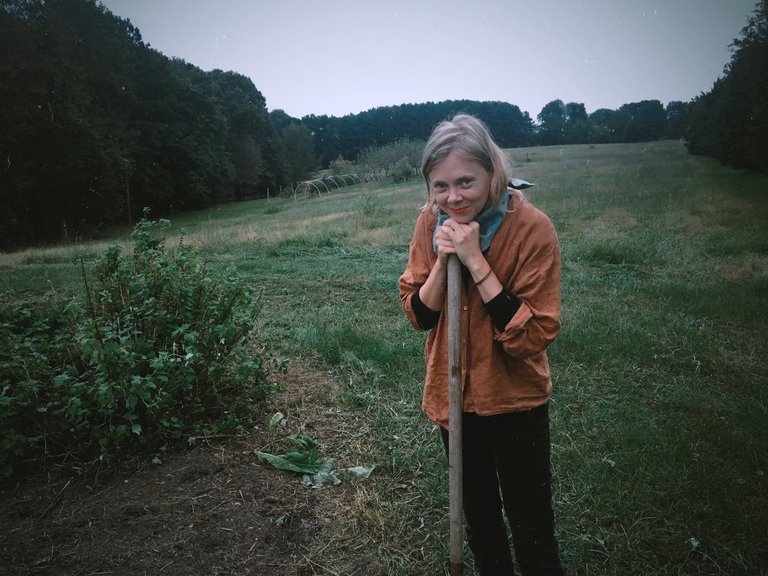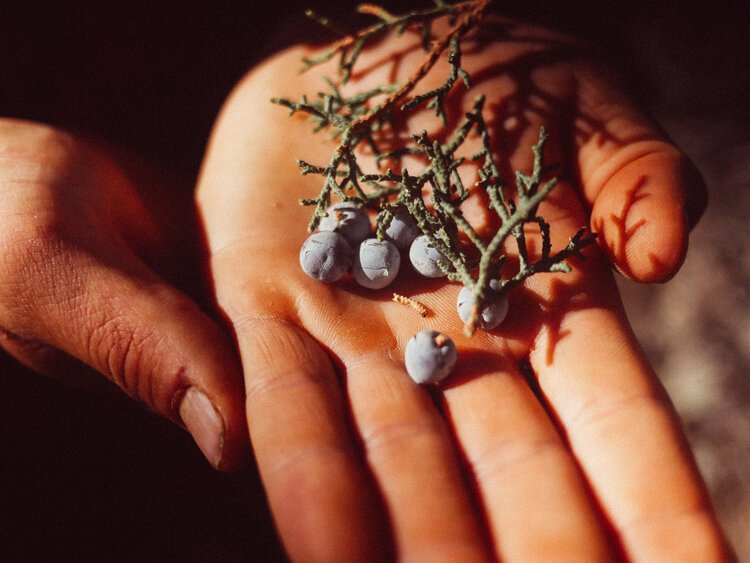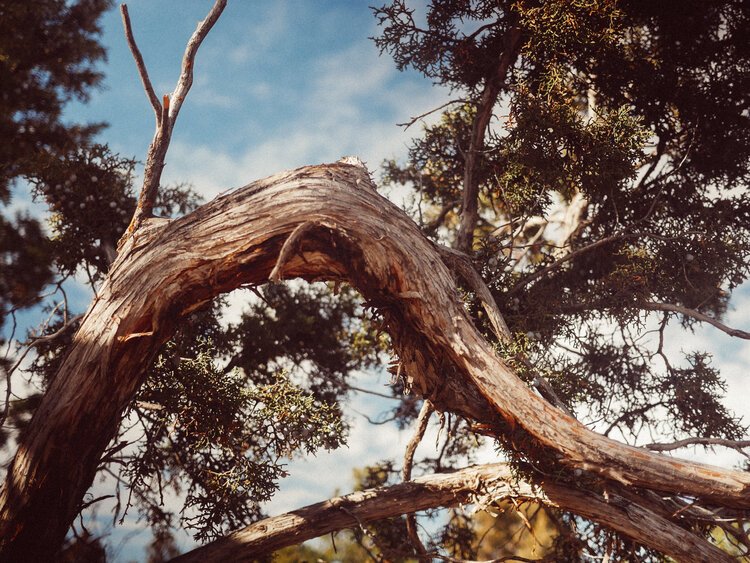Yesterday, I was working in my old herb garden in my hometown, in southern Virginia.
There’s something deeply relieving about revisiting a place that you’ve cultivated in some way.
Tending it and exchanging whatever energy through time you’ve tied yourself to each other through. There’s something to that, you know? Places are like that with me. Plants are like that with me, and gardens especially. All the kinds of gardens that can exist. Whether it was the Osha (Ligusticum porteri) seed I sprinkled in the soil cracks in the Wallowas, the Thyme (Thymus vulgaris) I planted at Dancing Springs in Barnardsville, the Calamus (Acorus calamus) at Juliet’s or in my parents’ creek sneakily buried in mud and grasses, the Monarda (Monarda spp.) and Elecampane (Inula helenium) I buried long ago in the soils of my dad’s little spot in the world.

It reminds me that I feel most whole while gardening, while taking care of plants, while watching them, and feeling an utter since of joy and heart-openness to plants that I only occasionally feel with humans. Or rather; plants allow me to step into the heart open realm a little more with humans.
My friend Kym and I processed Ginger (Zingiber officinale) with my dad from his greenhouse crop, tended all summer, making sure to keep the greenhouse doors open for the breeze to flow through. We dug Elecampane root, from plants I have put in the ground years ago but never harvested. I think they will enjoy a little ruffling, a little space to spread out- as I divided some of the roots and replanted the small ones elsewhere.
Whenever I hang out in that herb garden, I find myself often drawn to long staring into the wild hedgerow that follows a metal fence, all of it at the top of the property, on a little knoll. This knoll means I can hear things way in the distance, unfortunately the interstate sometimes, other times it is the donkey next door, hunting dogs or coyotes way out there. The hedgerow consists almost solely of Eastern Red Cedar or Juniperus virginiana. This is not an abnormal hedgerow to have in these parts of the world, especially on these high and dry sites. My papa has them at his farm in the field, along the fence line, along the pond. Pretty much everything at his farm— the old fence posts that still stand 75 years later, some of the farm equipment that back in the day they handmade and even black-smithed the iron parts- are made of this Cedar or Oak. The fence line might have Cedar posts, with live Cedar trees growing next to the posts wrapped in barbed wire and painted white. Sometimes they are rough hewn, other times they are made nicely.

Cypress plant family (Cupressaceae)
So, the Eastern Red Cedar I mention from my dad and papa’s farm, as well as other Juniperus species, are all in the Cypress plant family, or called the Cupressaceae. When I chat with my horticulturist dad about his ornamentals in this family, he refers to them as ‘Cupresses.’ Alongside Junipers, a few other members of this family that some folks might recognize include the grandiose Redwoods (Sequoia sempervirens) which mainly grow in coastal California, Incense Cedars which mainly grow in the Sierras of California with some range in northern California coastal and southern Oregon (Calocedrus decurrens), Western Red Cedar which is primarily found in the Pacific Northwest and northern California along the coast into B.C.(Thuja plicata), Yellow Cedar from southern Oregon up to Alaska (Cupressus nootkatensis) Cypress (Taxodium distichum), and Sequoia (Sequoiadendron giganteum) which is mainly located in the southern California Sierras range.
Cypress family plants are conifers, a broad general grouping characterized by their cone-bearing seed dispersing techniques. Not all Ccnifers are in the Cypress family though, as worldwide there are several plant families of cone-bearing species. Plants in the Cypress family, including Juniper species are considered gymnosperms, which is the name for the ‘naked seed’ dispersal techniques of older more ancient plant families that include all Conifers as well as trees like Gingko. Most plants in this family are evergreen, but a few are not. Their seed cones vary in style and structure. Some plants in this family have needle-like leaves, others scale-like, and some start off needle-like and move to scale-like in age. Plants in this family can be found pretty much all over the world, from some of the coldest or highest locations, to some of the lowest and warmest. They can be found in moist or dry locations, and often they are specialized to that ecology and location and can be rare where found. You’ve got Junipers up on high mountain peaks in Nevada, and Swamp Cypresses in Florida down in the lowlands- both genus’ are in this plant family.
My dad talks about selling all kinds of different ‘Cypress’ varieties at our family nursery that ran from the 60’s until two years ago in the Piedmont region of southern Virginia, this included a mixed of hybrid species, cultivated species and straight up wild species of different trees and shrubs in this family. After talking to him this week about it, he named some things he sold and used in landscape plantings including ‘Leland’ Cypress Cupressus × leylandii (a Monterey and Yellow/Nootka Cypress (Cupressus nootkatensis) cross, popularly used among horticulturists to plant fast shade. It’s mainly infertile, with a few exceptions), ‘Swamp/Bald’ Cypress Taxodium distichum (this species is found in the wild mainly in the southeastern U.S. lowlands), and ‘Italian’ Cypress Cupressus sempervirens (native to the Mediterranean).

He sold Cedrus species like ‘Blue Atlas’ Cedar Cedrus atlantica, (native to northern Africa) and ’Deodora’ Cedar, Cedrus deodara (native to the Himalayas) which are NOT actually in the Cypress family but the Pine family. These are the species the ‘Cedar’ common name is likely based on. He used Thuja species and cultivars like Arborvitae, ‘Green Giant,’ and ‘Green Emerald.’ The Juniperus species he used were ‘Blue Pacific,’ ‘Blue Rug,’ ‘Nick’s Compacta,’ ‘Blue Lake pfitzer’ and a lot of other different ones he couldn’t remember. He also planted trees that are in the Chamaecyparis genus in the Cypress family. Though my dad and I have completely different interests in plants (though that is changing on his end)— he in cultivars and ‘pretty’ things, I in ecology, medicine, ethnobotany and history of plants— we can talk about this stuff and be on the same page, or at least hold conversation. I can prompt him with some good questions and he knows what I am talking about.
In California, there are endemic species of Cypress that grow on serpentine soils like Cupressus sargentii and Cupressus macnabiana. Of course there are tons more Cypress’ out there and so much more to say about the Cypress plant family.
The Chamaecyparis genus includes the small range of coastal Port Orford Cedar of the West coast of Oregon and northern California (Chamaecyparis lawsoniana) and Atlantic White Cedar (Chamaecyparis thyoides) on the East coast from Maine down the southern coasts and even is found on the shores of the Gulf of Mexico.
In addition to the culturally significant Western Red Cedar of the Pacific Northwest (Thuja plicata), another Thuja grows in New England, the Great Lakes region and into the interior of Canada (Thuja occidentalis).
It’s interesting to note how many endemic species there are in the Cypress family. McNab Cypress in California, I hung out with when I lived in Nevada City, CA, only grows on serpentine soils for the most part. Monterey Cypress is endemic to one area in central California, yet is demonized as ‘invasive’ because it grows so well as an ornamental worldwide, and even in the Bay area of California it is being ‘eradicated.’ Yellow Cedar in Canada and Alaska which hugs the temperate coast, famous for its soft and resilient fibers, only grows in that region. Arizona Cypress is only found in a small area in Mexico, southern Texas, New Mexico and Arizona. These are just a new examples, in addition to the particularities of many species I’ve mentioned above.
Many species in the Cypress family are called ‘Cedar’ or ‘Cypress’ as common names regardless of their genus. This will be important to consider later, when we look at the ‘true Cedar’ label on some species.
Take note, even the rare prehistoric remnant species Torreya taxifolia of north Florida, or commonly named Stinking-Cedar, is in the Taxaceae family, not the Cypress family.
Thujas to note:
Thuja plicata (Western Red Cedar)
Thuja occidentalis (Northern White Cedar)
the other couple species of Thuja are native to Asia
Chamaecyparis’ to note:
Chamaecyparis thyoides (Atlantic White Cedar)
Chamaecyparis lawsoniana (Port Orford Cedar)
Cupressus’ to note:
Cupressus macnabiana(McNab Cypress)
Cupressus sargentii (Sargent’s Cypress)
Cupressus nootkatensis (Yellow Cedar)
Cupressus macrocarpa (Monterey Cypress)
Cupressus arizonica (Arizona Cypress)
Congratulations @ofsedgeandsalt! You have completed the following achievement on the Hive blockchain and have been rewarded with new badge(s) :
Your next target is to reach 60 posts.
You can view your badges on your board and compare yourself to others in the Ranking
If you no longer want to receive notifications, reply to this comment with the word
STOPSupport the HiveBuzz project. Vote for our proposal!
Beautiful.
I have always planted herbs whereever I've lived, even if I knew I'd be leaving soon. There's something really lovely about leaving that plant magic behind for others.
We don't get cedar here, but I wish we did! Beautiful post.
Thanks ! I’ve obsessed over these trees for awhile now. A shame you don’t have them or a relative nearby you.
I'll look into it - maybe we do and I haven't put my attention on them.
We do have some lovely redwoods near us!
https://www.visitotways.com/what-to-see-and-do/the-redwoods/